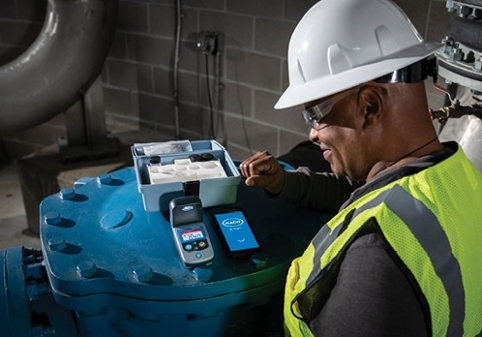A colorimeter is a light-sensing instrument that measures how light is absorbed and transmitted as it moves through a liquid sample.
Colorimeters follow the principles of the Beer-Lambert Law (Beer’s Law), which is the linear relationship between absorbance and concentration.
To analyze a specific analyte in a liquid sample, color-forming reagents are added. The color reaction is proportional to the concentration of the analyte.
High concentrations will absorb more of the light than a solution with a diluted concentration.
A colorimeter typically consists of several key components assembled to measure the absorbance or transmittance of light through a sample.
Light Source: This emits specific wavelengths of light, usually in the visible spectrum, directed towards the sample.
Sample Holder: A compartment where the sample is placed for analysis. It ensures consistent positioning and presentation of the sample to the light source and detector.
Filters or Monochromators: These components allow only certain wavelengths of light to pass through to the sample, ensuring precise measurement of specific colors or wavelengths.
Photodetector: This detects the intensity of light either transmitted through the sample or reflected from it. Common types include photodiodes or photomultiplier tubes (PMTs).
Amplifier and Signal Processor: This circuitry amplifies and processes the signal from the photodetector, converting it into a measurable output such as absorbance or transmittance.
Display and Controls: A user interface to adjust settings, view results, and control the operation of the colorimeter.
These components work together to provide accurate and reliable measurements of the color properties of a sample.
Yes, there is a way to prevent measurements from being saved automatically on the DR900 Multiparameter Portable Colorimeter. This can be done by disabling the auto-save feature in the device settings. Typically, you can access the settings menu on the colorimeter's interface and navigate to the data storage or data management section. From there, you should be able to find an option to toggle the auto-save function on or off. By turning off auto-save, the colorimeter will no longer save measurements automatically, allowing you to manually save or discard measurements as needed during your testing process.
To prevent data from being automatically stored onto the DR900, simply turn off the autosave feature. This can be done by selecting OPTIONS, then ADVANCED OPTION, then AUTOSAVE, and then OFF.
Principle:
A colorimeter operates on the principle of Beer-Lambert law, which establishes a direct relationship between the absorbance of light by a solution and the concentration of the solute, as well as the path length of light through the solution. The functioning of a colorimeter involves several steps:
- A colorimeter emits specific wavelengths of light, typically within the visible spectrum, towards the sample.
- The sample, which can be a liquid or a solid dissolved in a solvent, is placed in a sample holder. The light either passes through the sample or is reflected from it.
- A photodetector measures the intensity of the light that passes through the sample or is reflected from it. This measurement is then compared to a reference measurement, often the intensity of light passing through a blank solvent, to determine the absorbance or transmittance of the sample.
- The absorbance or transmittance values obtained are converted into concentration measurements using calibration curves or mathematical formulas based on the Beer-Lambert law.
Applications:
Colorimeters are versatile instruments with a wide range of applications across various industries and scientific fields:
- Chemical Analysis: In chemistry labs, colorimeters are utilized to determine the concentration of chemical solutions by measuring their absorbance at specific wavelengths.
- Environmental Monitoring: They play a crucial role in environmental science for monitoring water quality, analyzing pollutants, and measuring the concentration of nutrients in soil and water samples.
- Food and Beverage Industry: Colorimeters are essential tools for assessing the color, purity, and concentration of ingredients in food and beverages, ensuring quality control and consistency in production processes.
- Clinical and Biological Research: In biology and medicine, colorimeters find applications in enzyme kinetics studies, protein quantification, and drug analysis, among others.
- Industrial Quality Control: Colorimeters are instrumental in maintaining product standards and consistency across various industries such as pharmaceuticals, textiles, paints, and cosmetics, through rigorous quality control processes.
- Overall, colorimeters serve as indispensable instruments for quantitative analysis and quality assurance in a wide range of scientific, industrial, and commercial applications.
Handheld colorimeters by Hach are portable devices designed for convenient and accurate colorimetric analysis in various industries and applications. Here are some key features:
1. Portability: Hach handheld colorimeters are compact and lightweight, allowing for easy transport and use in the field or laboratory.
2. User-Friendly Interface: They feature intuitive user interfaces with easy-to-read displays and simple navigation buttons, making them accessible to users with varying levels of expertise.
3. Wide Range of Parameters: Hach offers handheld colorimeters capable of measuring a wide range of parameters, including but not limited to:
4. Calibration and Data Storage: These colorimeters typically allow for calibration with known standards to ensure accurate measurements. They also often include internal memory for storing measurement data, enabling easy retrieval and analysis.
5. Durable Construction: Hach handheld colorimeters are built to withstand harsh environmental conditions, with rugged housing and durable components for reliable performance in the field.
6. Battery-Powered Operation: They are powered by batteries, offering flexibility and convenience for use in remote locations or areas without access to power outlets.
7. Compliance and Certifications: Hach handheld colorimeters may comply with industry standards and regulations, ensuring that measurements meet quality control and regulatory requirements.
Overall, Hach handheld colorimeters DR900 and DR300 provide users with a portable, reliable, and efficient solution for on-site colorimetric analysis across a wide range of applications.





